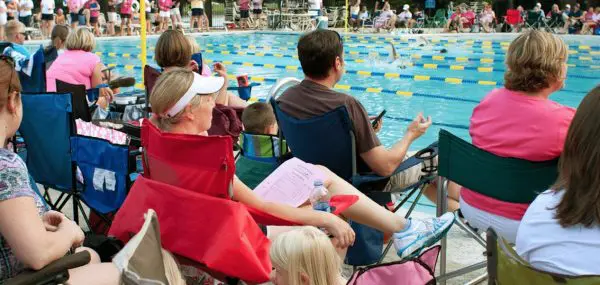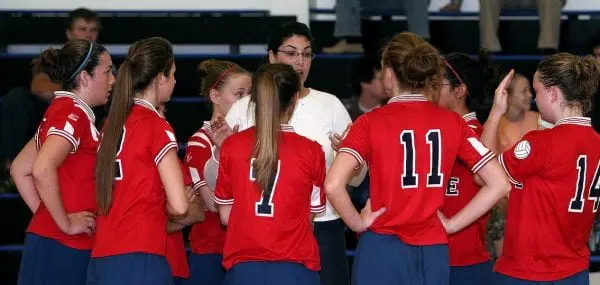While it’s unrealistic for the vast majority of student athletes to expect a sport will fund their entire college education, there is plenty of opportunity to play sports in college.
Advice for Athletes who Want to Play in College
Here’s advice for teenagers who want to stay in the game with no scholarship:
1. Be realistic. Ask your athlete: Why does she want to play sports in college?
Is it for the scholarship, the glory, and prestige of a big name program, or simply because she loves the game? If Division I is out of reach—DI is typically for the most elite players—and she still wants to play, it’s still possible. 
2. Look beyond Division I.
DI represents only 345 of the NCAA’s 1,066 member institutions. There are still hundreds of Division II schools, and Division III schools, with competitive, high-caliber athletic programs where your athlete can be “challenged, stretched, pushed, but they don’t own you, and you still get to enjoy a balanced college experience,” says Meredith. In addition, the National Association of Intercollegiate Athletics (NAIA), while smaller than the NCAA, represents 300 schools that offer athletic scholarships plus merit (academic) scholarships and financial aid.
“Everyone tends to focus on DI, but there are a lot of great opportunities at other levels,” agrees Julie Jones, head softball coach for the University of Akron.
3. Get your name out.
You can play sports in college without being recruited, but your student athlete must be proactive and market himself to get his name out there. Send coaches emails and highlight videos (YouTube is great for this, says Jones). Attend showcases, camps, or clinics that feature coaches from the colleges she is interested in. Your teenager should let the coach know that he is attending and would love to meet in person.
And there’s no need to pay for a pricey recruiting service.
“You can do so much of this on your own, so there is no need to spend thousands of dollars on recruiting when you may already be spending thousands of dollars to play,” notes Jones, who gets hundreds of emails a week from prospective players for her D1 team. “Get your name in front of a coach. Come to camps. Send emails. Put a video together.”
4. Do your research.
Jones also advises student-athletes do their research before approaching a coach. Coaches like to see that an athlete is knowledgeable about—and wants to join—their program. For example, Jones recently received an email from a player listing 50 reasons she wanted to play for the University of Akron. “It was awesome,” says Jones. “It showed she had paid attention and that she was really interested.” Athletes should also take the time to understand what a coach needs (online rosters are an easy way to do this, says Jones). Your teenager may be the star pitcher on his baseball team, but if a program doesn’t need a pitcher, the coach is not going to be particularly interested.
5. Make sure the school is a good fit.
Finally, advises Jones, parents should encourage teenagers to make sure the college is a good fit and not just for sports. “Make sure your kid understands that if they walk in the door and on day one they get hurt, they should still want to go to school there,” she says. Also, make sure you understand any limitations a school may place on your student athlete. “For example, there are a lot of schools that don’t allow kids to be a nursing major and still play sports,” says Jones. “So if your kid wants to be an engineer, make sure she can be an engineering major at the school.”
6. Be willing to play without a scholarship.
It’s also not unusual for students to play sports in college with no athletic scholarship. In fact, only Division I and Division II schools offer athletic scholarships. Division III schools do not. And the NCAA restricts full scholarships—a “full ride”—to the so-called “head count sports,” those considered revenue producers. For men, those sports are only basketball and Division I football. For women, they are basketball, volleyball, tennis, and gymnastics. In the other “equivalency” sports—such as soccer, crew, or lacrosse—athletes at Division I and Division II schools typically get partial scholarships, which is where a school divvies up a full scholarship among several student-athletes.
The bottom line: very few students—about two percent of all high school players—get any kind of athletic scholarship. That doesn’t mean your family needs to pay the sticker price of an institution for your student to play. To the contrary, there’s merit aid and financial aid available to athletes too. What’s more, being an athlete can help earn your student merit aid.
But parents of teenagers who want to play sports in college must do their research and manage expectations. “Our son thought he was going to be the next Dan Marino,” says Meredith. “We let it play out. At some point, he realized that Division I was not going to happen for him. But that didn’t stop him from wanting to play college ball, and for him, Division III was a great fit. He wasn’t a star, but he was still pursuing his dream.”




